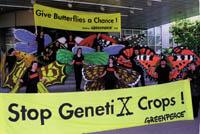GM Food: Debate on the table
Overeating, fat-eating, drinking alcohol, and, in general, poor eating habits often produce burning. The owners of the agricultural industries that benefit from biotechnology in their farms would also suffer their burning lately, not because of what they are eating, but because of the atmosphere of discussion that has been generated around genetically modified foods.

In Europe the debate on genetically modified foods is quite old. In the United States, so far, it has not happened, but as if it were a virus that has gone through the entanglement, the debate on genetically modified foods has already reached the United States. Recently, in Battle Creek, Michigan, a group of Greenpeace members held a protest action at Kellogg headquarters. As is known, Kellogg sells cereals from genetically modified seeds. Days later, another Greenpeace member carried out a spectacular action questioning Kellogg's work. The U.S. Food and Drug Association organized a conference on GM foods. In these days there appeared the guest surprise, the famous tiger of the house Kellog, Tony, but with the clothing of Frankenstein; therefore, the British press calls the GMO the food of Frankenstein. FrankenTony does not appear alone, as with him there was a group of children dressed in butterflies. The group of butterflies ate corn and represented death. Through this action, a group of researchers at Cornell University wished to echo the recent discovery that genetically modified corn could kill the caterpillars of the monarch species.
All this makes the United States already notice signs of change. According to rumors, the Secretary of Agriculture of this country, Dan Glikman, is about to form a group of experts in biotechnology. In addition, a group of 20 parliamentarians recently introduced a new bill regulating the specific and differentiated labeling of GM foods. The atmosphere of concern that has begun to awaken politicians towards GM food has not yet reached Americans. The truth is that they do not have many possibilities of change. Think about half of the U.S.-eaten, one-third of the corn, and most potatoes are extracted from genetically modified plants. In short, letxuGa, broccoli, cabbage, strawberries, plums and apples may be included.

Although they have not achieved the attention of the citizens, the groups of nature defense continue to work. For example, Greenpeace has put a lot of pressure on the child food company Gerber. This company uses genetically modified soy and corn in its products. Greenpeace was also very important in Monsanto's decision to abandon research on terminator seeds. In addition to Greenpeace there are doubts about the subject from other aspects. One of the heads of the US Environmental Monitoring Forum, Rebecca Goldberg, said: "I, as a biologist, find it hard to be against the genetic transformation of food, but I think the potential risks to health and ecology need to be taken into account."
The debate has focused mainly on health problems. No one has yet been able to show that genetically modified foods are harmful to health. In the case of rats, however, there has been some session, and a British researcher has assured that genetically modified potatoes have scared the napes of the garlic in their laboratory. Some say otherwise, as a group of scientists have recently referred to the benefits of genetically modified foods. According to them, genetically modified foods are beneficial to health, since by containing more food and producing less waste, chemical contamination is reduced. They say more, that being natural doesn't always mean it's good, and they put examples that if some foods aren't cooked well they can be toxic.
The U.S. Food and Drug Association has so far approved 40 genetically modified plants for human consumption, but in the coming years more will be admitted. In Europe the list is much lower but will increase. Therefore, people who distrust GM foods are encouraging work for a differentiated and special label for these foods. This pressure from social groups may influence, but at the moment it does not seem that GM multinationals succumb. The solution, however, may come from elsewhere, by those who work with traditional foods. If the problem is the label, the brand “Product not genetically modified” also has its strength and charm.
Published in 7
Buletina
Bidali zure helbide elektronikoa eta jaso asteroko buletina zure sarrera-ontzian











